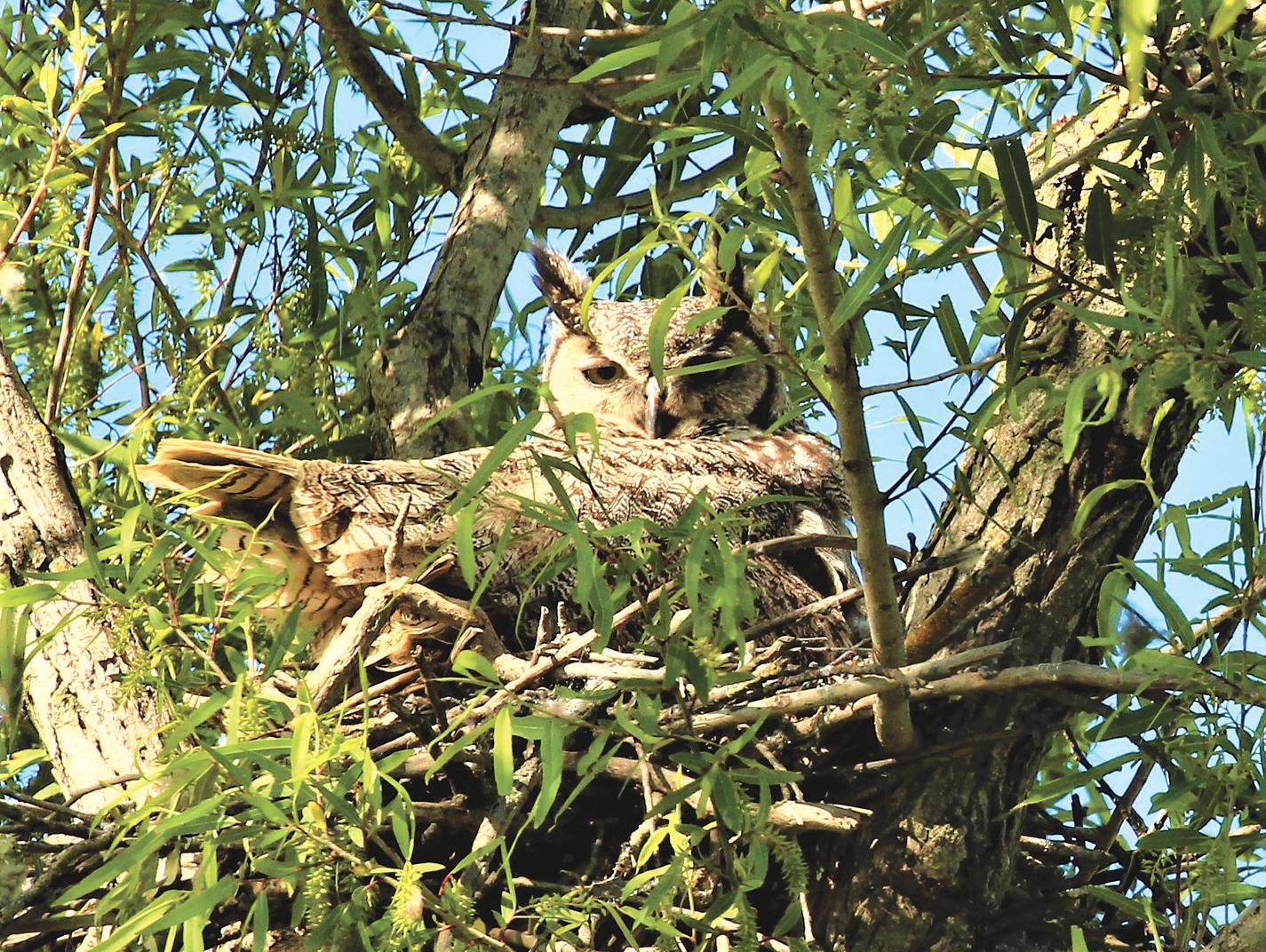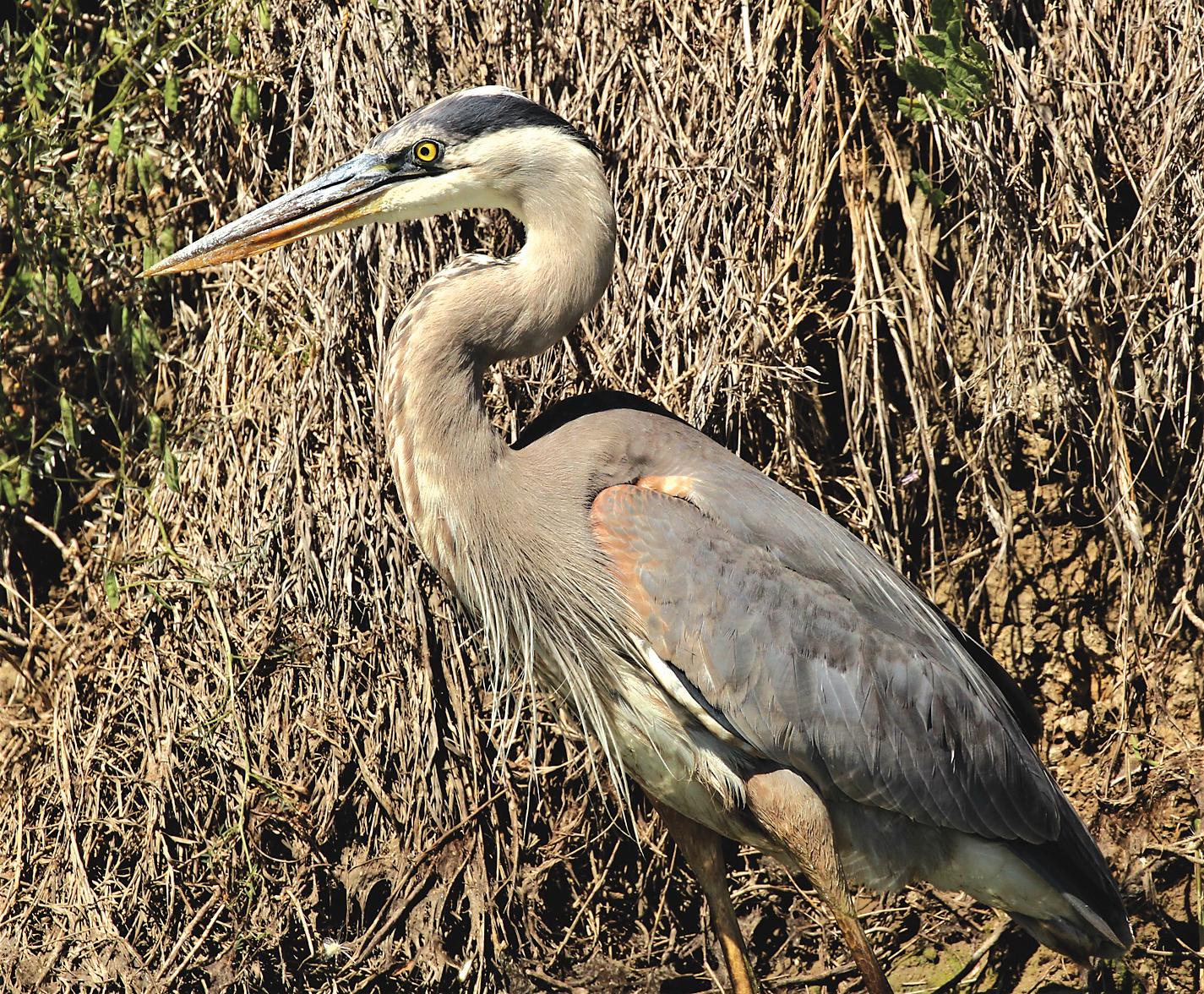
5 minute read
Animals & Their Allies
Bird Watching Bird Watching WILDLIFE FINDS REFUGE AT YOLO BASIN PRESERVE
CR C R
By Cathryn Rakich Animals & Their Allies
Great horned owl at Yolo Bypass Wildlife Area. Photo by Mark Rakich
Nestled 40 feet high in the branches of a willow tree, the great horned owl scrutinizes her surroundings. Two chicks are barely visible within the confi nes of their twisted twig nest.
Despite her skyward proximity and camoufl age feathers, the bird of prey comes into touchable view through a spotting scope. Her home, along with 200 other bird species, is the stateowned Yolo Bypass Wildlife Area.
Stretching 16,000 acres across both sides of the Yolo Causeway along I-80 between Sacramento and Davis, the nature refuge is managed by the California Department of Fish and Wildlife for fl ood control, animal and habitat protection, recreation and education.
On an early summer Saturday, I join fi ve other visitors and three docents from the nonprofi t Yolo Basin Foundation for a tour of the area’s native grasslands, riparian forests and seasonal wetlands.
We follow a lead guide, each in our own vehicle, along the gravel “auto tour” loop, pulling over along the way, cameras and binoculars in hand. Red-winged blackbirds, snowy egrets, great blue herons, a red-tailed hawk, Swainson’s hawk, American white pelican and the great horned owl are among the 29 species we witness.
The raptors and shorebirds are primarily year-round residents. November through January, our guide tells us, the skies and wetlands are painted solid with migrating waterfowl.

Great blue heron at Yolo Basin wetlands. Photo by Mark Rakich
YOLO BYPASS WILDLIFE AREA EVENTS
The Yolo Basin Foundation offers numerous educational programs and events throughout the year.
GUIDED TOURS
Guided tours—October through June—take place at the Yolo Bypass Wildlife Area. The driving tours, with several stops and optional short walks, are appropriate for all levels of outdoor enthusiasts. While the wildlife area is open free to the public every day from sunrise to sunset (except Dec. 25 and periods of fl ooding), a guided tour is recommended for fi rst-time visitors. “Taking a tour helps introduce people to how to navigate the wildlife area,” says Martha Diepenbrock, executive director of the Yolo Basin Foundation. “When you go back on your own, you have more confi dence on where to go.” Tour guides often scout wildlife prior to the tour, and come prepared with spotting scopes and loaner binoculars. A $10 per-person donation is encouraged.
The Yolo Bypass Wildlife Area supports millions of migrating birds, including ducks and geese, who need a stopover on their annual north-tosouth trek along the Pacifi c Flyway. The wetlands provide open water and vegetation for nourishment and rest.
Yet 90 percent of the Central Valley’s wetlands have been lost due to development and other factors. “Waterfowl and shorebirds migrating through the Central Valley today are surviving off of isolated, postage stamps of wetlands across a landscape of agriculture and urban development,” reports the National Audubon Society.
In a mutually benefi cial partnership between man and nature, much of the Yolo Basin land is leased to rice farmers. In return, the rice fi elds provide food and habitat to the wildlife who depend on the fi elds for survival. Come fall, after the rice is harvested, the migrating birds, as well as year-round residents, dine on the precious white grains left in the fi elds.
It’s rice planting season during our guided tour and crop dusters fl y low across the terrain. “Most people think when they see the planes that they’re dropping pesticide,” Diepenbrock says. “When they see those planes fl ying low over the rice fi elds, they are planting.”
But the drought continues to threaten these surrogate wetlands. Less rain and snow mean less water devoted to agriculture, which results in fewer rice fi elds to support Sacramento Valley’s wildlife. “Millions of waterfowl and scores of other wildlife species in California lose critical habitat if fewer acres of rice are planted,” reports the California Rice Commission.
The Yolo Bypass Wildlife Area “has old riparian water rights that go back a long time,” Diepenbrock says. “That’s why the wildlife area has been able to have some water. There is a lot of pressure on all the various species that depend on the wetlands and the water that is now all managed.”
Our 9-mile tour ends at Parking Lot G where we are greeted by hundreds of cliff swallows as they dive and dance in the sky above our heads. An old wooden bridge provides shelter and structure for the swallows to build their gourd-shaped mud nests, lined with dry grass to keep their chicks warm.
“You see so many different things over the course of the year,” Diepenbrock says. “Go out there more

BAT WALKS
These family-friendly walks let visitors experience the “fl yout” of the largest urban colony of Mexican free-tailed bats in California. The Bat Walks take place multiple evenings through late September. The popular bat tours sell out quickly. “But when people cancel, we open those spots up again, so checking back is the best way,” Diepenbrock says. Tickets are $15 for adults, $5 for youth 6–17 years, and free for children 5 and younger.
STARGAZING
Sign up for stargazing at the Yolo Bypass Wildlife Area with amateur astronomers from the Davis Astronomy Club. Viewings include constellations, star clusters, galaxies, colored stars, the moon, Venus and Saturn. The tour is Saturday, Aug. 6, 7–11:30 p.m. Registration is $125 per person and includes drinks and hors d’oeuvres at sunset.
To sign up for events, volunteer and donate, visit yolobasin.org. n
than once. The water changes. The animals change. The birds change. The sky changes. Each time is its own experience.”
For more information, visit yolobasin.org.
Cathryn Rakich can be reached at crakich@surewest.net. Previous columns can be found and shared at InsideSacramento.com. Follow us on Facebook, Twitter and Instagram: @insidesacramento. n










